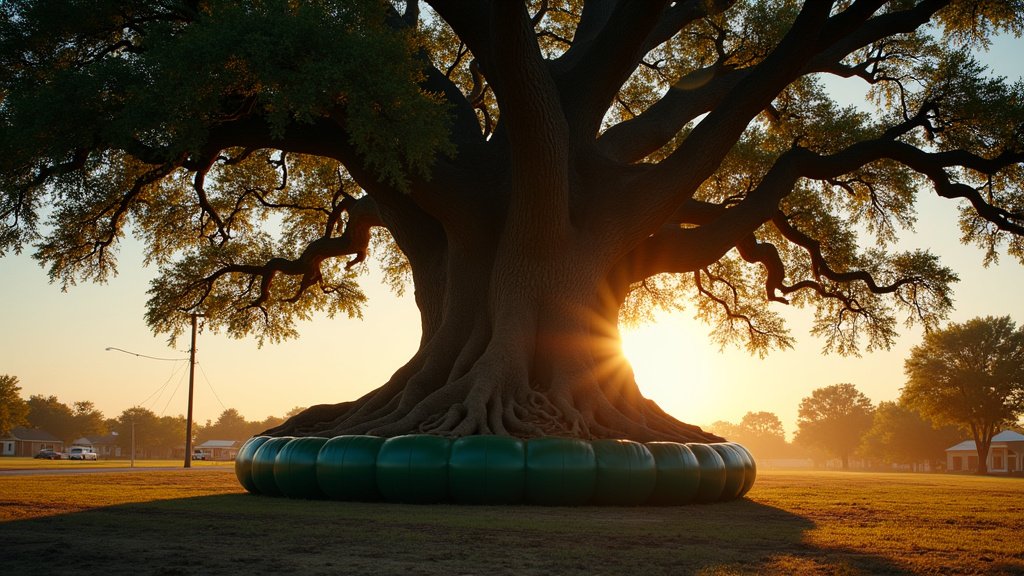In a remarkable feat of engineering and environmental stewardship, the city of Kyle, Texas, is undertaking an extraordinary project to relocate a majestic 400-year-old oak tree, affectionately nicknamed “Jolene,” at a cost approaching $1 million. This ambitious endeavor aims to preserve a significant piece of local history and nature amidst ongoing urban development, employing a sophisticated and rarely used high-tech system.
A Living Landmark Faces Development
Known officially as the Old Stagecoach Heritage Oak Tree, “Jolene” has stood as a silent witness to centuries of Texas history, predating the United States itself. This venerable live oak, boasting a trunk diameter of approximately 51 inches, is a cherished landmark in Kyle, a rapidly growing city south of Austin. However, its prime location along Old Stagecoach Road, which is undergoing a vital widening project to accommodate increasing traffic, placed it precariously close to the edge of the pavement, merely six inches away. This proximity created a hazardous “pinch point,” disrupting traffic flow and necessitating a difficult decision.
For years, discussions have been underway regarding the future of the tree, with initial plans in late 2024 leaning towards its removal, potentially to be commemorated through art or by planting new trees. This prospect sparked significant community outcry, with residents launching petitions that garnered over 2,000 signatures and even staging protests, including one individual who physically occupied the tree’s branches to prevent its removal. The sentiment was clear: “Jolene” is more than just a tree; it’s a symbol of the town’s heritage.
Responding to this public pressure and recognizing the tree’s immense historical value, the Kyle City Council ultimately voted in February 2025 to pursue relocation rather than removal. This decision, while controversial for some due to the substantial cost, underscores a commitment to balancing necessary infrastructure improvements with the preservation of significant natural assets.
The ArborLift Innovation: High-Tech Preservation in Action
To undertake such a monumental relocation, the City of Kyle contracted Environmental Design, Inc. (EDI), a company renowned for its expertise in complex tree transplanting. EDI employs the patented ArborLift system, a cutting-edge technology that represents a significant advancement in tree moving. This innovative method is designed to safely and efficiently transport massive trees, even those weighing over a million pounds, while causing minimal disruption to their extensive root systems.
The ArborLift system utilizes a series of pneumatic air bladders strategically placed beneath a rigid lifting platform. These bladders are inflated with computer-controlled precision, providing a stable, gentle, and evenly distributed lift. This process allows the entire root ball to be secured and lifted without the stress and damage often associated with traditional methods using cranes or heavy machinery. Once lifted, the tree is carefully transported on the platform to its new location.
This high-tech approach is considered rare, with only a handful of cities globally having utilized the ArborLift system for tree relocations. Its application in Kyle highlights a growing trend in municipal projects to employ advanced solutions for environmental preservation.
The Million-Dollar Price Tag and Long-Term Commitment
The total cost for “Jolene’s” relocation is projected to be around $932,800. This substantial investment covers a comprehensive suite of services: pre-treatment for the tree, the intricate relocation process itself, a rigorous 24-month aftercare plan, necessary road restoration work, water valve installation, and the creation of a dedicated “parklet” or pocket park at the tree’s new home. This new site, located approximately a quarter-mile north of its original position and chosen for its compatible soil profile and proximity, will be specifically designed to protect and showcase the ancient oak.
While relocation does not offer a 100% guarantee of survival, as noted by certified arborists, the city and EDI are committed to the extensive monitoring and maintenance required to give “Jolene” the best possible chance of thriving. This includes tracking soil conditions, moisture levels, and encouraging root regrowth over the two-year period following the move.
Balancing Growth and Heritage in Texas
The “Jolene” tree relocation project in Kyle, Texas, serves as a compelling case study in the modern challenges of urban expansion. As Texas continues its rapid growth, cities face increasing pressure to develop infrastructure while simultaneously confronting the desire to preserve their natural and historical heritage. This high-profile tree move exemplifies the lengths to which some communities are willing to go to protect their natural treasures.
Beyond the immediate project, the initiative has also spurred conversations about local tree ordinances and the mitigation costs associated with development. Advocates are pushing for stricter regulations to ensure that future growth is managed more sustainably, with greater emphasis on preserving mature trees and natural landscapes.
As “Jolene” embarks on its new journey, its relocation stands as a testament to innovation in environmental engineering and a community’s dedication to safeguarding its past for future generations. This $1 million news story from Texas is not just about moving a tree; it’s about investing in history and finding new ways for nature and progress to coexist.






